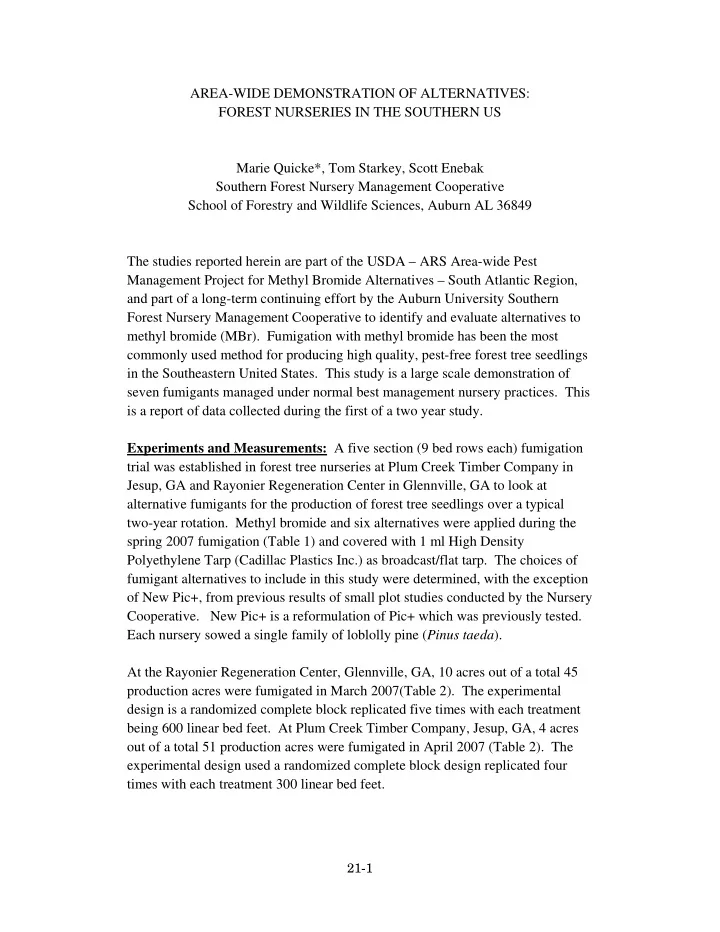

AREA-WIDE DEMONSTRATION OF ALTERNATIVES: FOREST NURSERIES IN THE SOUTHERN US Marie Quicke*, Tom Starkey, Scott Enebak Southern Forest Nursery Management Cooperative School of Forestry and Wildlife Sciences, Auburn AL 36849 The studies reported herein are part of the USDA – ARS Area-wide Pest Management Project for Methyl Bromide Alternatives – South Atlantic Region, and part of a long-term continuing effort by the Auburn University Southern Forest Nursery Management Cooperative to identify and evaluate alternatives to methyl bromide (MBr). Fumigation with methyl bromide has been the most commonly used method for producing high quality, pest-free forest tree seedlings in the Southeastern United States. This study is a large scale demonstration of seven fumigants managed under normal best management nursery practices. This is a report of data collected during the first of a two year study. Experiments and Measurements: A five section (9 bed rows each) fumigation trial was established in forest tree nurseries at Plum Creek Timber Company in Jesup, GA and Rayonier Regeneration Center in Glennville, GA to look at alternative fumigants for the production of forest tree seedlings over a typical two-year rotation. Methyl bromide and six alternatives were applied during the spring 2007 fumigation (Table 1) and covered with 1 ml High Density Polyethylene Tarp (Cadillac Plastics Inc.) as broadcast/flat tarp. The choices of fumigant alternatives to include in this study were determined, with the exception of New Pic+, from previous results of small plot studies conducted by the Nursery Cooperative. New Pic+ is a reformulation of Pic+ which was previously tested. Each nursery sowed a single family of loblolly pine ( Pinus taeda ). At the Rayonier Regeneration Center, Glennville, GA, 10 acres out of a total 45 production acres were fumigated in March 2007(Table 2). The experimental design is a randomized complete block replicated five times with each treatment being 600 linear bed feet. At Plum Creek Timber Company, Jesup, GA, 4 acres out of a total 51 production acres were fumigated in April 2007 (Table 2). The experimental design used a randomized complete block design replicated four times with each treatment 300 linear bed feet. 21-1
Soil samples were collected pre-sowing, post-sowing and midsummer, and divided. One sample was plated onto media selective for the soil fungus, Trichoderma, which was quantified for each treatment. The other half was examined for nematodes using the Nematode Laboratory, Auburn University. Seedling counts were done within the beds at four and eight weeks. Seedlings were collected at eight weeks. Seedling quality as measured by root collar diameter, height and dry weight and weeds were done following the eight week sample. Soil and seedling samples will be collected at 12 weeks, as well as pre- and post-sowing, midsummer and fall the second year. Results and Discussion: At four weeks post-sowing, seedling counts at Jesup resulted in chloropicrin having two seedlings per square foot more than the other treatments (Figure 1). A small increase or decrease in seedling counts on a total nursery production basis can affect revenue significantly. A two seedling per square foot increase for the whole nursery could result in as much as $117,000 additional revenue. At the Glennville nursery, the seedling count data was confounded due to severe wind damage that occurred shortly after sowing. The soil data at four weeks post-sowing indicates significantly high levels of Trichoderma in the methyl bromide treatment (Table 3). This is consistent with previous Nursery Cooperative research showing Trichoderma is an important soil borne fungus necessary for proper growth of pine seedlings. Levels of Trichoderma in the DMDS + Chloropicrin treatment were encouraging since previous studies indicated that DMDS alone did not favor Trichoderma development. At four weeks post-sowing, nematodes were not detected in any treatment. 21-2
Table 1. Fumigants and rates used in 2007 Area–wide demonstration plots. Fumigant Rate Components MBr 350 lbs/a 67% MBr & 33% Chlor DMDS + Pic 74 gal/a (731 lb/a) 79% DMDS & 21% Chloropicrin MBC 70/30 400 lbs/a 70% MBr (98/2) & 30% Solvent A New Pic+ 300 lbs/a 85% Chloropicrin + 15% Solvent B Pic+ 300 lbs/a 85% Chloropicrin + 15% Solvent A Chloropicrin 300 lbs/a 100% Chloropicrin Pic-Chlor 60 400 lbs/a 60% Chlor. & 40% 1,3-D Table 2. Trial Information for each location Jesup, GA Glennville, GA Fumigation 3-Apr-07 20-Mar-07 Fumigation type Broadcast/flat tarp Broadcast/flat tarp Area in trial 4 acres 10 acres Air temperature range 67° to 88°F 50° to 78°F Wind speed 3 – 6 mph 3 – 13 mph Soil moisture 8.5% 5.5% Soil series Norfolk loamy sand Tifton loamy sand Plastic in place 7 days 7 days 21-3
Figure 1. Four week post-sowing seedling counts from Jessup, GA nursery 30 a Seedling Count (per sq ft) 25 b Target Seedling Density bc bc c c c 20 15 10 5 0 r n + + S C 0 B i C C 6 D B r M c I I M M r P i P o p w D l o h e r C o N l h C Letters for each treatment indicate significant differences at the 0.05 level. Table 3. Four week post fumigation soil fungi data Jesup Glennville Treatment Mean cfu/g soil Proportion of Mean cfu/g soil Proportion of of total fungi 1 Trichoderma of total fungi Trichoderma 61 b 2 MBC 0.37 bc 178 c 0.50 bc DMDS + Pic 118 a 0.48 ab 103 d 0.82 a Chloropicrin 127 a 0.38 bc 197 bc 0.29 d PIC+ 133 a 0.27 c 184 c 0.35 cd NewPIC+ 140 a 0.31 bc 211ab 0.38 cd MBr 144 a 0.60 a 222 a 0.60 b Chlor 60 146 a 0.35 bc 196 bc 0.22 d 1 cfu/g = colony units per gram. 2 Letters within a column indicate significant differences at the 0.05 level. 21-4
Recommend
More recommend